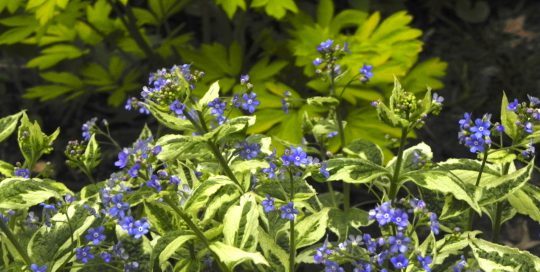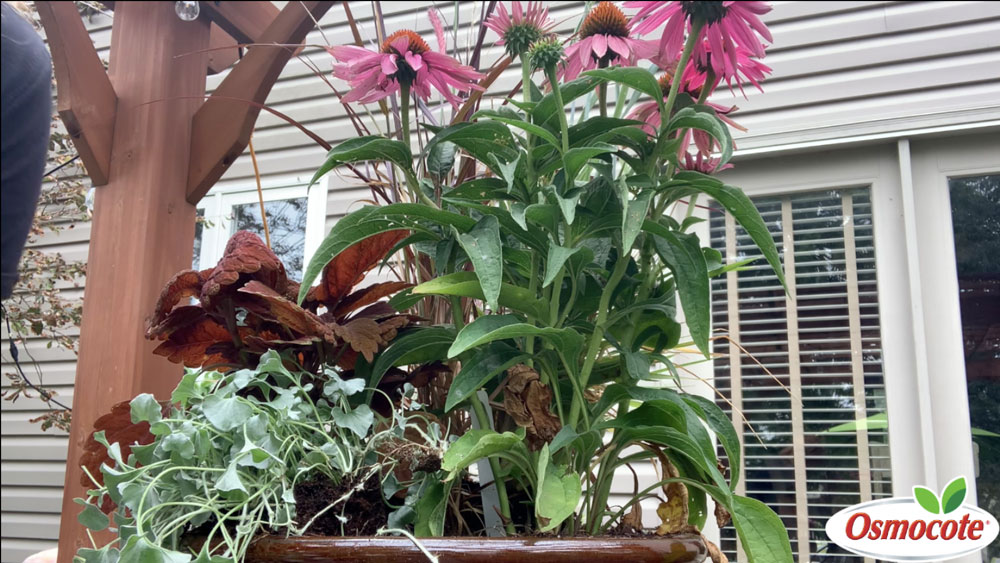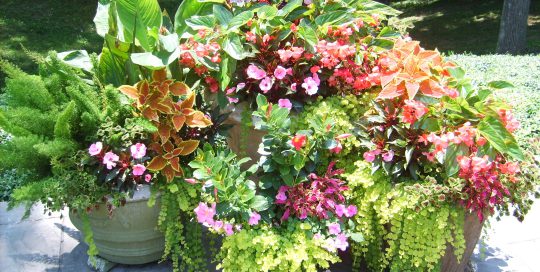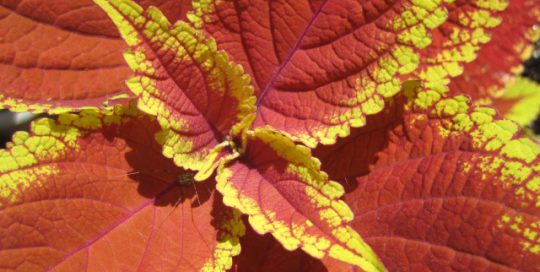There is nothing frivolous about coleus. It’s the perfect plant for gardeners and non-gardeners who love practicality. My mother, who liked coleus. was a “Depression baby” who re-used bread bags and aluminum foil. She never bought anything that wasn’t on sale, and would try a new brand or flavor because she “had a coupon for it.” She didn’t get teary-eyed over a bouquet of roses, but she’d ask my Dad and I to get coleus when we shopped for plants in the spring.
Coleus provided the best bang for the buck compared with Petunias, which would grow leggy by July, or geraniums, which require a bit of fussing. Mom liked the way coleus functioned as color guards that flanked the front porch all summer long. All they needed was an occasional watering — a good thing when you have seven kids to take care of.
Since those days, a lot has happened to plants in general, and coleus specifically. Sometime between the 1960s and the 21st century, breeders once again discovered the functional beauty of this Indonesian native. From upright to trailing, from vigorous to delicate, it goes with anything colors. Today coleus is a mainstay at any garden center.
What’s to love?
According to Ray Rogers in his book Coleus: Rainbow Foliage for Containers and Gardens, the most important quality of coleus is its easy-to-care-for nature. Ray’s book offers some insight into why that is so. In recent times it seems that coleus has been declared a sun-loving plant. When breeders went to work creating new coleus hybrids, they noticed some were more sun-tolerant than others. Factors that contribute to a coleus’ ability to thrive outside of a shady corner included leaf color and thickness, and soil moisture.
In general, Rogers says, darker-colored varieties tolerate more sun than paler ones, with yellow-leaved cultivars falling somewhere in the middle. All bets are off, however, if you decide to increase a plant’s sun exposure.
“Even normally sun-tolerant cultivars can burn when plants that are kept in a relatively low-light area are suddenly moved into brighter light,” Rogers warns.
Plant Care
It’s a good practice to leave a container in the shade for a couple of days after it’s been planted. Ideally, it should be moved gradually into more and more sun, all the while monitoring its moisture, especially if the weather is hot. And if you want to see what a coleus looks like in more shade, just look inside the plant where the sun doesn’t penetrate. I noticed that, with the cultivar called ‘Campfire’, the leaves growing just 10 inches below the stem tips could be from a different plant entirely. Leaves at the top of the plant were a rich, bright, and nearly solid orange, while those lower on the plant were a muted orange with an irregular chartreuse edging.
How Did Coleus Get Its Name?
There is some name confusion in the coleus world, but it’s nothing new. When Karl Blume discovered it in the wilds of Java and introduced it to English gardeners in 1853, it was called Coleus blumei in honor of Blume. It wasn’t until this century that it was placed into a different genetic category, and twice! The first name change was to Solenostemon scutellarioides. That didn’t last long. The plant now has a more easily pronounced name, Plectranthus (Pleck-TRAN’-thus). Houseplant aficionados may recognize that as the botanical name for Swedish ivy. Because it could be decades (if at all) before gardeners start referring to the plant as Plectranthus, most people will continue to call it coleus.
My Favorite Varieties of Coleus
I’ve enjoyed growing nearly two dozen different varieties of coleus over the past three seasons. Some, like ‘Fishnet Stockings’ and ‘Inky Fingers’ I’ve grown several times because their combination of lime and deep purple appeal to me.
Fishnet Stockings
One variety that always finds its way into my cart is ‘Fishnet Stockings’. With its precise lines of burgundy coursing through large chartreuse leaves, it never fails to catch my eye. It’s a large plant (to 30”), and mixes well with anything sporting deep red flowers.
Wasabi
The name ‘Wasabi’ says it all—bright and hot and a shade of chartreuse that never fails to attract attention. Add deeply serrated edges on its leaves and it’s hard for any coleus fan to do without it. Plant a stand of Gomphrena ‘Fireworks’ in front of it and it will add excitement to your garden all season long.
Marooned
ColorBlaze ‘Marooned’ can be your go-to choice for deep, rich, velvety, solid red foliage. It’s one of the tallest of the bunch, as it can reach three feet in height, but its slender, scalloped foliage. This cultivar cries out for companions in pale to bright pink to bring out its mahogany hues.
Campfire
‘Campfire’ is a large upright cultivar that falls into the deep orange category. Everything about it is big, and it demands lots of space. Its nearly solid-colored leaves love to be paired with variegated green and cream foliage and coral-colored flowers.
Saturn
‘Saturn’ is a stunner, and as the weather heats up, it will show why it was given its name. Electric yellow-green forms a line down the center of each leaf, and is surrounded by a wide ring of deep red. And to give it a little extra character, small, irregular spots of the same green stipple the red trim. It’s an upright grower that seldom passes 24-inches in height.
Inky Fingers
‘Inky Fingers’ has a lot going for it. Labeled a “duckfoot” variety, its deep purple and bright green leaves are heavily scalloped. It’s a mounding coleus that makes a great filler that will cascade around the outside of a container or spread at a height of around 18-inches in the ground.
Trailing Plum
‘Trailing Plum’ makes the perfect subject for hanging baskets and as cascading color for containers. Its small leaves contain purple with a luminescent band of plum at the outside edge. You have to be a little careful about the amount of sun this foot-tall plant gets—it likes just enough to give it the best color but not enough to burn its leaves. This variety is also known as ‘Swinging Linda’, ‘Meandering Linda’ or ‘Trailing Plum Brocade’.
Coleosaurus
‘Coleosaurus’ is a different animal in the sun than it is in partial shade. It’s beautiful in either location. Give it plenty of sun (and water) and it will be bright chartreuse and deep red. In partial shade, where I grow it, it will be bright lime green and burgundy, not unlike ‘Fishnet Stockings’ but with much more detail. It is a big and burly plant, and goes beautifully with deep red Pelargonium.
Marrakesh
In Lonely Planet’s introduction to Marrakesh, the city, Jessica Lee writes that “it fizzes with life.” ‘Marrakesh’ the coleus does the same thing. It’s got a lot going on, from its tri-lobed leaves that sometimes throw in a few extra scallops to its random-patterned ruby and chartreuse coloration, you might think it would be over-the-top busy. But it works. It also has a great habit—very compact, each 12”-16” stem loaded with leaves.
Yellow Dragon
Be careful combining ‘Yellow Dragon’ with other plants. It’s considered a miniature—slow-growing and topping out at around 10 inches. Its narrow yellow leaves are deeply scalloped and trimmed with a narrow red edge. This little cutie is a candidate for growing indoors, and in a mixed container, should be combined with other small, non-aggressive plants.
Heuchera
If you have trouble growing Heuchera, or think you have too much sun for coleus, give them another try. While they don’t enjoy the same conditions as succulents, they prefer not to be relegated to the same situation as Impatiens.
Sources:
Taylor Greenhouses, Portland, NY
Glasshouse Works, Stewart, OH
Rosy Dawn Gardens, New Hudson, MI
International Coleus Society offers a youtube video called Killer Coleus
Coleus: Rainbow Foliage for Containers and Gardens by Ray Rogers









